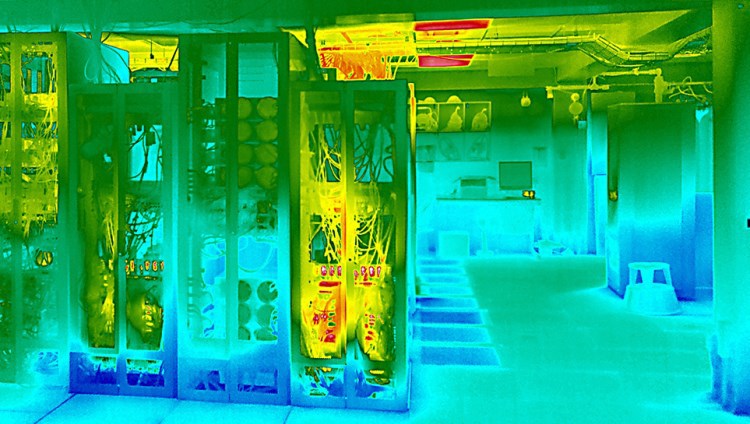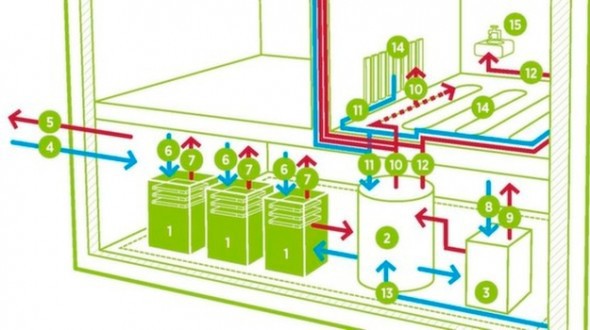How to warm up for a "foreign" account
Data centers usually do not use all the heat that they generate, but there are many ways to use it 100% efficiently. For example, in your own home in the middle of winter in some corner of the planet that does not indulge in a mild climate. You can, of course, live right in the data center. But seriously, it is enough to have a small data center that produces the necessary amount of heat at home or in the office.

Back in 2011, Microsoft Research announced that there is a sense and a commercial benefit in the idea of using the energy generated by computers for space heating and water heating. The consumer gets free heating, and the cloud service provider company may not invest in building and maintaining huge sites. All win! Because some companies have begun to actively implement this technology in life.
')
The German company Cloud & Heat offers a kind of "cloud heaters", which are a metal cabinet with access to the water supply system, which is "stuffed" with a whole set of hard drives, boards and fans. You buy and install such a cabinet, which costs as well as a conventional heating system (about $ 15 thousand), connect it to the ventilation system, water supply, electricity (three phases, 400 V) and the Internet (at least 50 Mbps). The company pays for Internet connection and the cost of running the equipment, and you get as much free heat and hot water as the server inside the cabinet can produce during work.

However, Cloud & Heat should not be worried about the excess costs with which the cloud platform is usually associated. Among other things, the company receives a very extensive network, which helps to avoid many problems in the operation of equipment and software. Cloud & Heat guarantees equipment maintenance for 15 years. It may seem that such data storage is not an absolutely reliable option, however, servers are hidden inside the cabinets, and the data on the disks is encrypted and reserved.

The French company Qarnot is pursuing a similar idea, but puts emphasis on a separate room, heated with a high-performance processor. The Q.rad technology is an electric radiator with a direct temperature dependence on the volume of data processed. After installation in the house, the radiator produces as much heat as Qarnot customers need, and if there is more heat than needed, you can redirect resources to the University of California's BOINC research project. Like Cloud & Heat, Qarnot pays for electricity, considering it a fair deal, because significantly saves on infrastructure.

Both companies are still in the early stages of project development, although in a commercial sense, Cloud & Heat went a little ahead, because focused on equipping offices, because there can be placed much more equipment. Of course, it will be several years before the technology completely replaces the data centers and the conventional heating system, but if all the plans come true, you will only have to wait for such an innovation to spread around the world.

Despite the fact that the idea of heating due to the operation of the equipment is very tempting, there remain a number of issues that may arise from both the user of the cloud service and the one who uses its heat. Chief among them is data security. Cloud & Heat claims that all of their customer data is stored within Germany. However, the problem is that surely knowing who exactly is heating your “cloud” is impossible. Of course, the data is encrypted and, according to the company, only company personnel have direct access to the equipment. And yet, I would like to know for sure that in case of problems with the Internet connection or electricity at the location of the server, the data will be saved and redirected via the extensive network of the Internet provider.
Other questions, for example, how many users the company has, whether there are agreements with other cloud providers to provide additional capacity, if it is needed, remain open. Therefore, it is too early to talk about the full launch of technology, but let us hope that this innovation will someday reach us.
PS Let it always be warm in your home ...

Back in 2011, Microsoft Research announced that there is a sense and a commercial benefit in the idea of using the energy generated by computers for space heating and water heating. The consumer gets free heating, and the cloud service provider company may not invest in building and maintaining huge sites. All win! Because some companies have begun to actively implement this technology in life.
')
The German company Cloud & Heat offers a kind of "cloud heaters", which are a metal cabinet with access to the water supply system, which is "stuffed" with a whole set of hard drives, boards and fans. You buy and install such a cabinet, which costs as well as a conventional heating system (about $ 15 thousand), connect it to the ventilation system, water supply, electricity (three phases, 400 V) and the Internet (at least 50 Mbps). The company pays for Internet connection and the cost of running the equipment, and you get as much free heat and hot water as the server inside the cabinet can produce during work.

However, Cloud & Heat should not be worried about the excess costs with which the cloud platform is usually associated. Among other things, the company receives a very extensive network, which helps to avoid many problems in the operation of equipment and software. Cloud & Heat guarantees equipment maintenance for 15 years. It may seem that such data storage is not an absolutely reliable option, however, servers are hidden inside the cabinets, and the data on the disks is encrypted and reserved.

The French company Qarnot is pursuing a similar idea, but puts emphasis on a separate room, heated with a high-performance processor. The Q.rad technology is an electric radiator with a direct temperature dependence on the volume of data processed. After installation in the house, the radiator produces as much heat as Qarnot customers need, and if there is more heat than needed, you can redirect resources to the University of California's BOINC research project. Like Cloud & Heat, Qarnot pays for electricity, considering it a fair deal, because significantly saves on infrastructure.

Both companies are still in the early stages of project development, although in a commercial sense, Cloud & Heat went a little ahead, because focused on equipping offices, because there can be placed much more equipment. Of course, it will be several years before the technology completely replaces the data centers and the conventional heating system, but if all the plans come true, you will only have to wait for such an innovation to spread around the world.

Despite the fact that the idea of heating due to the operation of the equipment is very tempting, there remain a number of issues that may arise from both the user of the cloud service and the one who uses its heat. Chief among them is data security. Cloud & Heat claims that all of their customer data is stored within Germany. However, the problem is that surely knowing who exactly is heating your “cloud” is impossible. Of course, the data is encrypted and, according to the company, only company personnel have direct access to the equipment. And yet, I would like to know for sure that in case of problems with the Internet connection or electricity at the location of the server, the data will be saved and redirected via the extensive network of the Internet provider.
Other questions, for example, how many users the company has, whether there are agreements with other cloud providers to provide additional capacity, if it is needed, remain open. Therefore, it is too early to talk about the full launch of technology, but let us hope that this innovation will someday reach us.
PS Let it always be warm in your home ...
Source: https://habr.com/ru/post/244519/
All Articles